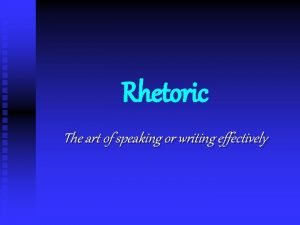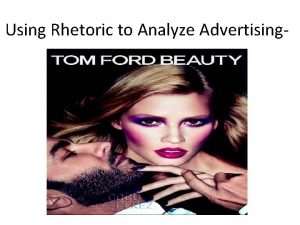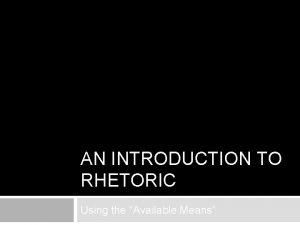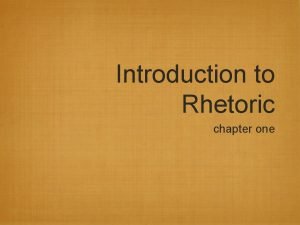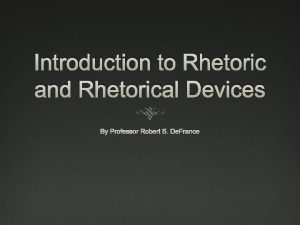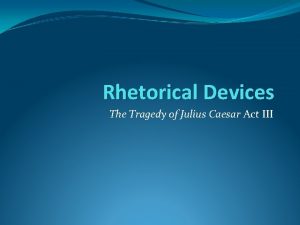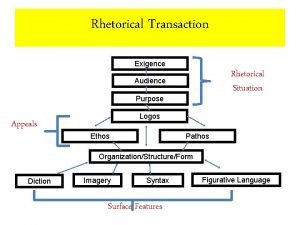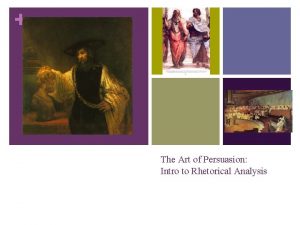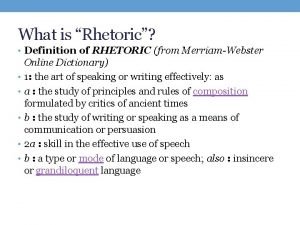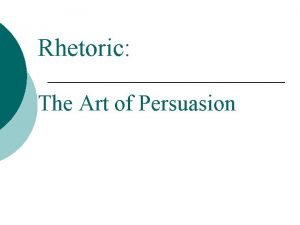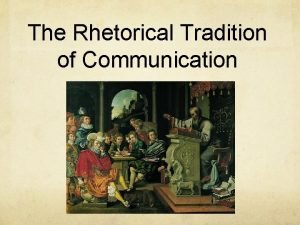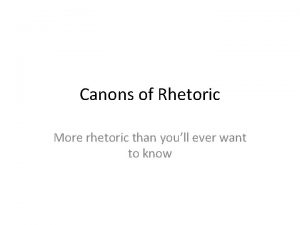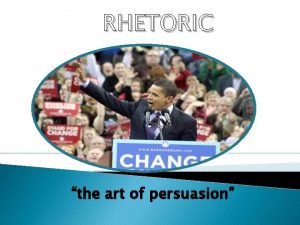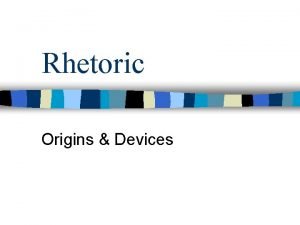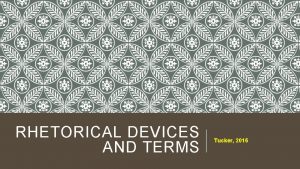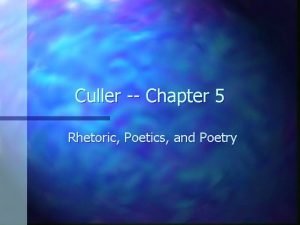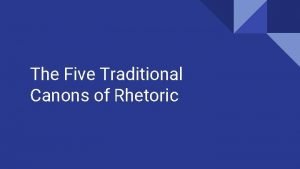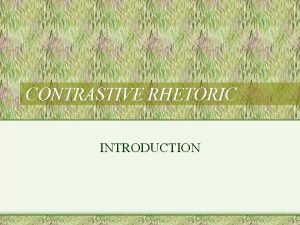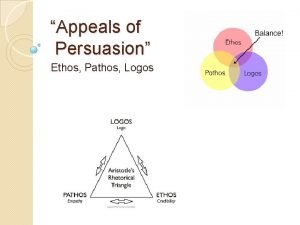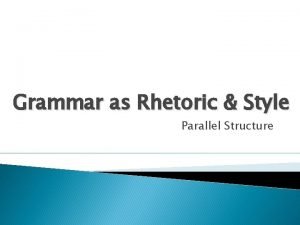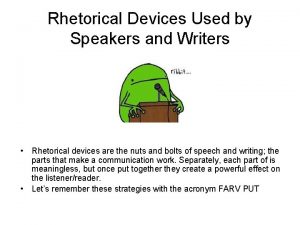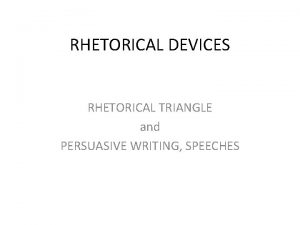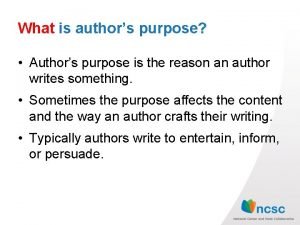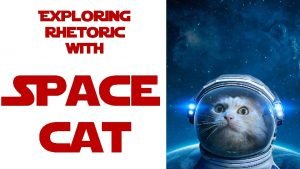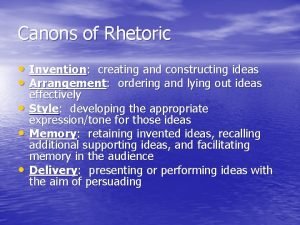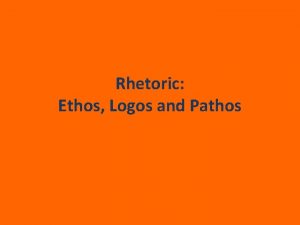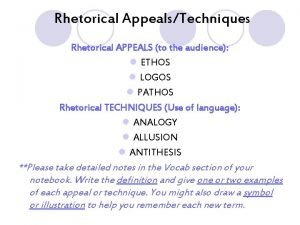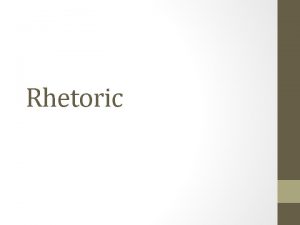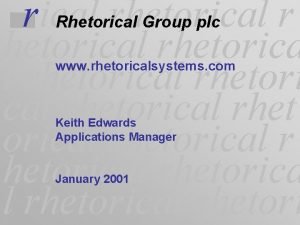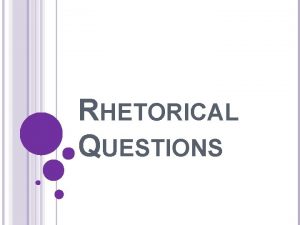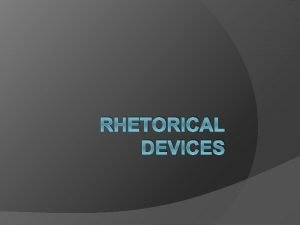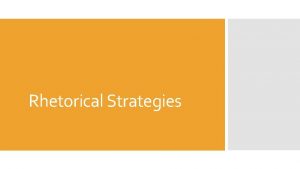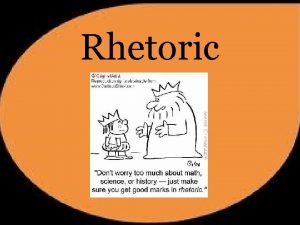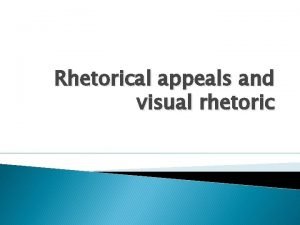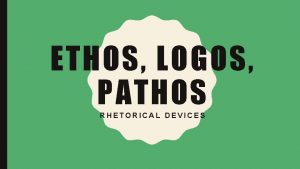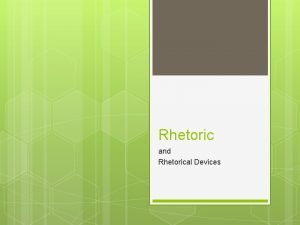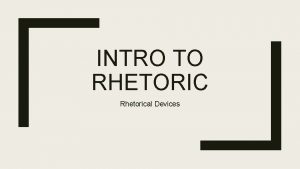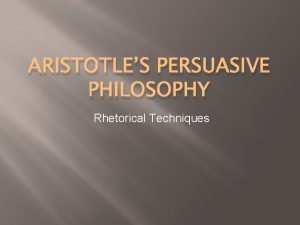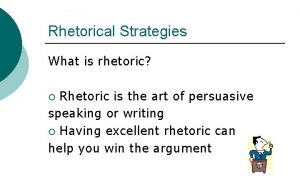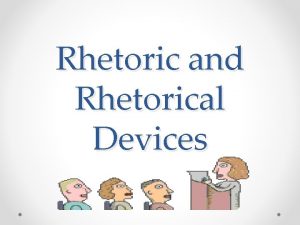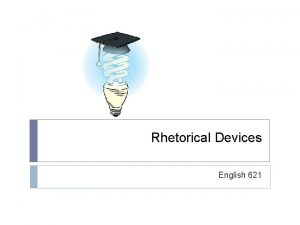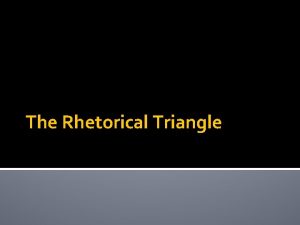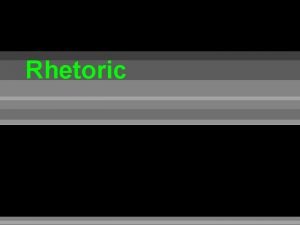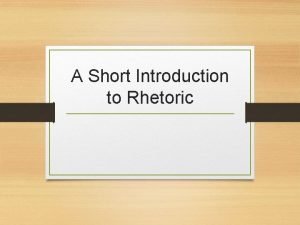Rhetorical Keystones What Is Rhetoric Plato Rhetoric is

![What Is Rhetoric? �Plato: [Rhetoric] is the "art of enchanting the soul. " (The What Is Rhetoric? �Plato: [Rhetoric] is the "art of enchanting the soul. " (The](https://slidetodoc.com/presentation_image_h/93088523611435cc34d47c2cf7347c12/image-2.jpg)































- Slides: 33

Rhetorical Keystones
![What Is Rhetoric Plato Rhetoric is the art of enchanting the soul The What Is Rhetoric? �Plato: [Rhetoric] is the "art of enchanting the soul. " (The](https://slidetodoc.com/presentation_image_h/93088523611435cc34d47c2cf7347c12/image-2.jpg)
What Is Rhetoric? �Plato: [Rhetoric] is the "art of enchanting the soul. " (The art of winning the soul by discourse. ) �Aristotle: Rhetoric is "the faculty of discovering in any particular case all of the available means of persuasion. " �Cicero: "Rhetoric is one great art comprised of five lesser arts: inventio, dispositio, elocutio, memoria, and pronunciatio. " Rhetoric is "speech designed to persuade. "

Essential Elements in Rhetoric xt e t n Wh at i s th e to Speaker ? pose ur p e th s i t a Wh d? e s u e r a es i g e Wh t a r t at s ne? co e th s i at h W is t a Wh The “text” ? xig e the ? y c en ? ct e j ub s e h t is at h W Audience

Tools for Examining Rhetoric 1. Diction 2. Appeals 3. Rhetorical devices 4. Tone 5. Literary devices 6. Exigency 7. Syntax 8. Structure

1. Diction = Word Choice �Creates tone, attitude, and style �Why does the “speaker” choose the words and phrases that he does? �What denotation do the words have? �What connotation do the words have?

2. Syntax = Sentence Construction �Grammatical construction �Simple �Complex �Repetition �Inverted �Questions �Imperatives �Exclamations �Punctuation �Parallelism

3. Literary /Rhetorical Devices � Allegory � Alliteration Literary devices: � Allusion � Figurative language (metaphor, simile, non-literal language) � Imagery (sensory images) � Irony/satire/parody � Metonymy (representative term used for actual object: White House) � Motif � Onomatopoeia � Oxymoron � Personification � Pun � Synecdoche (part represents the whole: “all hands on deck”)

Literary / Rhetorical Devices (cont. ) Rhetorical devices: �Antithesis (two contrasting images/phrases) �Hyperbole (“this is the most used strategy of all time!”) �Deduction/Induction (general to details/details to general) �Pacing �Rhetorical question �Understatement �Ellipsis (. . . ) �Anaphora (“I came, I saw, I conquered. ”)

4. Overall Structure �Induction/deduction �Examples �Compare/contrast �Cause and effect �Classification �Process �Definition �Narration �Description �Spatial

Related to “Modes of Discourse” �Exposition = illustrates a point �Narration = tells a story �Description = creates a sensory image �Argumentation = takes a position on an issue and defends it

5. Appeals �Ethos �Logos �Pathos

Ethos �What does the person tell us about him or her? �How trustworthy is the speaker? �How valid is the information the speaker uses? �How biased is the speaker?

Logos �What kind of information is used? �How reliable is the information? �How logical is the information? �How “documented” is the information?

Pathos �How does the speaker appeal to our emotions? �How much does the speaker make us feel about the subject of his or her message? �What kind of emotional responses does the audience have about the message?

6. Tone and Purpose �What is the purpose of the speaker’s message? �What is the speaker’s attitude towards his or her subject? �What is the speaker’s attitude towards his or her audience?

Some Tones � angry � tired � confused � sentimental � sharp � bitter � childish � Fanciful � upset � dreamy � peaceful � condescending � silly � restrained � mocking � sympathetic � boring � proud � objective � contemptuous � afraid � dramatic � vibrant � apologetic � happy � sad � frivolous � humorous � hollow � cold � audacious � horrific � joyful � urgent � shocking � sarcastic � allusive � joking � somber � nostalgic � sweet � poignant � giddy � zealous � vexed � detached � Provocative � irreverent

7. Exigency �What is the context of the “text”? �What is the need for this message? �What does the “world” lack that is being argued for in the “text”?

Activities to Practice Rhetorical Analysis

Practicing Rhetorical Analysis with a Film

Rhetorical Context of 300 This film is a fictionalized account of the Battle of Thermopylae of 480 BCE where an alliance of Greek city-states fight the invading Persian army in the mountain pass of Thermopylae. Though the oracles and the elders of Sparta warn King Leonidas not to fight the Persians (a force of over 100, 000 soldiers!), he still does, enlisting the help of 300 Spartans, 700 Thespians, and a few other slave soldiers. Vastly outnumbered, the Spartans hold-off the Persians for three days, but they need reinforcements. The king’s wife, Queen Gorgo, asks the Spartan Council to send in the rest of the Spartan army to help the 300. This is her speech to the Spartan Council.

Assignment �Take notes on the text of the speech. �http: //www. americanrhetoric. com/Movie. Speeches/m oviespeech 300 queengorgo. html

Gorgo Speech �Watch speech again, paying special attention to the audience’s reaction and the strategies that Gorgo uses. �What strategies does she use? �Prompt: “Write an essay that defines the central argument of Queen Gorgo’s speech and analyze the rhetorical strategies that she employs in her argument. ”

Text of the Queen Gorgo’s Speech Councilmen, I stand before you today not only as your Queen: I come to you as a mother; I come to you as a wife; I come to you as a Spartan woman; I come to you with great humility. I am not here to represent Leonidas; his actions speak louder than my words ever could. I am here for all those voices which cannot be heard: mothers, daughters, fathers, sons -- 300 families that bleed for our rights, and for the very principles this room was built upon. We are at war, gentlemen. We must send the entire Spartan army to aid our King in the preservation of not just ourselves, but of our children. Send the army for the preservation of liberty. Send it for justice. Send it for law and order. Send it for reason. But most importantly, send our army for hope -- hope that a king and his men have not been wasted to the pages of history -- that their courage bonds us together, that we are made stronger by their actions, and that your choices today reflect their bravery.

More Practice: Word Choice & Allusion in Bruce Springsteen’s “The Rising”

Some Background on Springsteen � Bruce Springsteen was born on September 23, 1949, in New Jersey. � His songs focus on “heartland rock, ” with poetic lyrics and Americana elements. Much of his writing focuses on working class people on the East coast. � Some of his best known albums are Born to Run, Born in the USA, and The Rising. He likes “thematic” albums. � Besides selling more than 65 million albums in the United States and 120 million worldwide, he has earned at least 20 Grammy Awards, two Golden Globes, and an Academy Award. � Rolling Stone Magazine ranked him as the 23 rd greatest artist of all time in its 100 Greatest Artists of All Time list.

Listen to the Song “The Rising” � Can't see nothin' in front of me Can't see nothin' coming up behind I make my way through this darkness I can't feel nothing but this chain that binds me Lost track of how far I've gone How far I've gone, how high I've climbed On my back's a sixty pound stone On my shoulder a half mile of line Come on up for the rising Com on up, lay your hands in mine Come on up for the rising tonight I see you Mary in the garden In the garden of a thousand sighs There's holy pictures of our children Dancin' in a sky filled with light May I feel your arms around me May I feel your blood mix with mine A dream of life comes to me Like a catfish dancin' on the end of the line Left the house this morning Bells ringing filled the air I was wearin' the cross of my calling On wheels of fire I come rollin' down here Sky of blackness and sorrow (a dream of life) Sky of love, sky of tears (a dream of life) Sky of glory and sadness (a dream of life) Sky of mercy, sky of fear (a dream of life) Sky of memory and shadow (a dream of life) Your burnin' wind fills my arms tonight Sky of longing and emptiness (a dream of life) Sky of fullness, sky of blessed life (a dream of life) Come on up for the rising Come on up, lay your hands in mine Come on up for the rising tonight Li, li, li, li, li, li There's spirits above and behind me Faces gone black, eyes burnin' bright May their precious blood bind me Lord, as I stand before your fiery light Li, li, li, li, li Copyright © 2002 Bruce Springsteen (ASCAP)

Answer Questions about “The Rising” � Write down many details about the narrator and make inferences about the narrator? (who, what, where, when, how, and why) And the audience? � Word choice: what is the significance/meaning of these words and phrases? Especially note the italics. � "this chain that binds me" � "sixty pound stone" � "Left the house this morning" � "bells ringing" � "Wearin' the cross of my calling" � "wheels of fire" � "rollin' down here" � "Faces gone black" � "Mary in the garden" � "garden of a thousand sighs" � "catfish dancin' on the end of a line" � "lay your hands in mine" � "dream of life" � "li, li, li"

More Questions �Why use the pairs of words after each "Sky of" phrase? What is the effect? �Explain the meaning of the four lines of the chorus: "Come on up for the rising" etc. �What is the mood of the song? (How does it feel? ) �Why is the song called "The Rising"? �What is the message of this song?

More Information about “The Rising” � One person’s interpretation: http: //teachertrenches. blogspot. com/2008/09/springsteen s-rising-and-september-11 th. html � It earned Grammy awards for Best Rock Song and Best Male Rock Performance of the year. Rolling Stone named it the 35 th best song of the decade. � During the 2008 U. S. presidential election, "The Rising" was first used as a closing campaign rally song by the John Edwards campaign. Despite the song's grim setting, the "Rise up" refrain matched the closing exhortation of Edwards' speeches. The Hillary Rodham Clinton campaign then began to use the song as well, especially at the end of her rallies or victory celebrations. Following Springsteen's April 2008 endorsement of Barack Obama, the Obama campaign began replacing U 2's "City of Blinding Lights" with "The Rising" as their commencement-of-rally song. (From wikipedia. com)

More on the Song �The song was also played immediately following Obama's victorious presidential acceptance speech on the night of November 4, 2008 in Grant Park in Chicago. Rolling Stone later remarked of its use there, "when its metaphor of struggling through darkness was blasted at Obama's victory celebration, it became a national anthem for the 21 st century. ” (from wikipedia. com)

Key Elements in an Opening Paragraph 1. Author and title of the piece. 2. Thesis that answers what the prompt is asking �Normally, this includes the meaning of the piece with the elements that convey the meaning 3. Devices that help interest the reader to continue your essay 4. BUT NOT TOO LONG! (4 to 5 sentences)

Tips on Writing Body Paragraphs 1. Try to organize paragraphs around a major 2. 3. 4. 5. stylistic device being used in the passage. This is where you present your analysis related to what you said in the opening paragraph. As much as possible, use quotations, specific references, and details from the passage. Place quotation marks around the words, phrases, and sentences that you take from the passage. You should be referring to the key ideas from the prompt from your opening paragraph.

Big Difference! 1. Remember that the biggest difference between the mediocre/average essay and the excellent essay is the ability to explain how the strategies that you identify help to explain the meaning of the text! 2. It’s your ability to answer the question: SO WHAT? !? !? !?
 The art of speaking or writing effectively
The art of speaking or writing effectively 3 types of rhetoric
3 types of rhetoric An introduction to rhetoric using the available means
An introduction to rhetoric using the available means How is rhetoric defined in this chapter
How is rhetoric defined in this chapter Detente apush
Detente apush Antistrophe examples
Antistrophe examples Paradox rhetorical device
Paradox rhetorical device Exigence rhetoric
Exigence rhetoric Enthymeme definition
Enthymeme definition Rhetoric merriam webster
Rhetoric merriam webster Analyzing visual rhetoric
Analyzing visual rhetoric Rhetoric the art of persuasion
Rhetoric the art of persuasion What is rhetorical tradition
What is rhetorical tradition Canon of rhetoric
Canon of rhetoric Rhetoric: the art of persuasive writing and public speaking
Rhetoric: the art of persuasive writing and public speaking Aristotle rhetoric
Aristotle rhetoric Parallelism examples rhetorical device
Parallelism examples rhetorical device Poetry vs rhetoric
Poetry vs rhetoric Canons of rhetoric
Canons of rhetoric Rhetoric
Rhetoric Contrastive rhetoric definition
Contrastive rhetoric definition Logos pathos ethos
Logos pathos ethos Anaphora vs parallel structure
Anaphora vs parallel structure Hugh blair lectures on rhetoric
Hugh blair lectures on rhetoric Rhetorical devices
Rhetorical devices Ethos pathos logos
Ethos pathos logos What is the author's purpose? *
What is the author's purpose? * Exigence space cat
Exigence space cat Juxtaposition
Juxtaposition Canons of rhetoric
Canons of rhetoric Ethos
Ethos Rhetoric poetry
Rhetoric poetry Ethos advertisement examples
Ethos advertisement examples Rhetorical devices in art
Rhetorical devices in art
